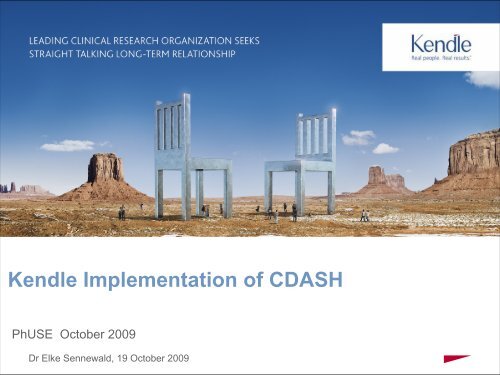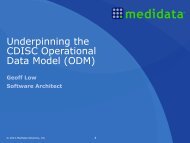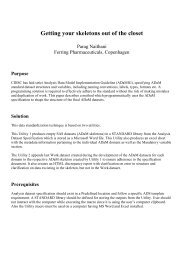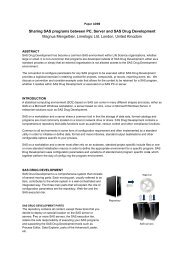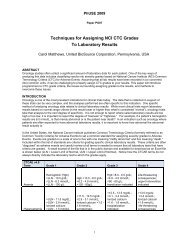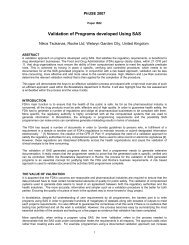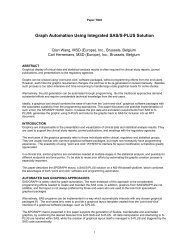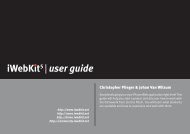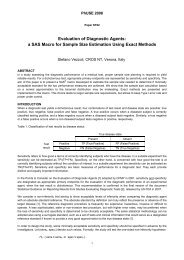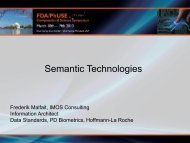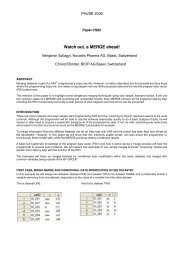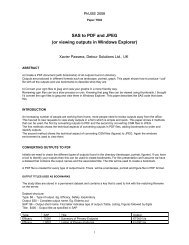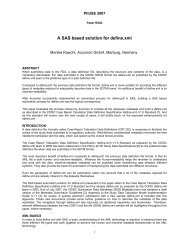Kendle Implementation of CDASH - PhUSE Wiki
Kendle Implementation of CDASH - PhUSE Wiki
Kendle Implementation of CDASH - PhUSE Wiki
- No tags were found...
You also want an ePaper? Increase the reach of your titles
YUMPU automatically turns print PDFs into web optimized ePapers that Google loves.
<strong>Kendle</strong> <strong>Implementation</strong> <strong>of</strong> <strong>CDASH</strong><strong>PhUSE</strong> October 2009Dr Elke Sennewald, 19 October 2009
Outline• Formation <strong>of</strong> <strong>CDASH</strong> Team• Theoretical Development <strong>of</strong> <strong>Kendle</strong>’s <strong>CDASH</strong> Standard• Practical <strong>Implementation</strong>• Mapping to SDTM and Data Validation Plan• Progress to Date and Future Plans• Repeating the Rewards2N N o o r r t t h h A A m e e r r i i c c a a •• E u r r o p e • A s i a / P a c i f i c • L a t t i i n A m e e r r i i c c a a • • A A f f r r i c i c a a
Formation <strong>of</strong> <strong>CDASH</strong> Team
<strong>CDASH</strong> Draft Published• April 2008 - CDISC put the draft <strong>of</strong> the <strong>CDASH</strong> (clinical data acquisitionstandards harmonization) documents out for public review• Draft consisted <strong>of</strong>:– Introduction– List <strong>of</strong> <strong>CDASH</strong> domains with recommendations on variables to be collected, whyand how• Primary goal was “the development <strong>of</strong> ‘content standards’ for a basic set <strong>of</strong>global data collection variables that will support clinical research studies“• <strong>Kendle</strong> decided to take the risk that this draft was near final and commencedesign <strong>of</strong> eCRF modules compliant with <strong>CDASH</strong>4N N o o r r t t h h A A m e e r r i i c c a a •• E u r r o p e • A s i a / P a c i f i c • L a t t i i n A m e e r r i i c c a a • • A A f f r r i c i c a a
<strong>Implementation</strong> PrinciplesFullCommunication Accountability Efficiency<strong>Kendle</strong>ProjectBASICSLeaderEnhancedCommunicationProactiveSolution FocusTransparency Consistency5N N o o r r t t h h A A m e e r r i i c c a a •• E u r r o p e • A s i a / P a c i f i c • L a t t i i n A m e e r r i i c c a a • • A A f f r r i c i c a a
<strong>Kendle</strong>’s <strong>CDASH</strong> Team Formation• June 2008 – <strong>Kendle</strong>’s <strong>CDASH</strong> team was formed with members from aroundthe world representing CDM, Biostatistics, Programming and ClinicalDevelopment• Each team member took on responsibility for one or more <strong>CDASH</strong> domainswith the objective to:– review and understand the intention <strong>of</strong> <strong>CDASH</strong> re the domain– transfer the <strong>CDASH</strong> specs into <strong>Kendle</strong>’s Study Definition Specification spreadsheet– cross reference as necessary to the CDISC SDTM controlled terminology list• We thought this would be easy….6N N o o r r t t h h A A m e e r r i i c c a a •• E u r r o p e • A s i a / P a c i f i c • L a t t i i n A m e e r r i i c c a a • • A A f f r r i c i c a a
Theoretical Development <strong>of</strong><strong>Kendle</strong>’s <strong>CDASH</strong> Standard
First <strong>CDASH</strong> Considerations• July 2008 – we found it was not so easy….• <strong>CDASH</strong>, although reflecting the needs <strong>of</strong> SDTM, is not necessarily conduciveto a database design– some domains can be collected once per study, once per visit or many times pervisit– several domains have a very “vertical” structure – which is not immediatelytransferable to a database specification• We discovered that we needed to supplement <strong>CDASH</strong> standards with ourown <strong>Kendle</strong> standards• Clinical input at this stage was vital – in order to define what were the mostlikely real-life scenarios we would encounter in the use <strong>of</strong> our standard eCRFs8N N o o r r t t h h A A m e e r r i i c c a a •• E u r r o p e • A s i a / P a c i f i c • L a t t i i n A m e e r r i i c c a a • • A A f f r r i c i c a a
<strong>CDASH</strong> Form Specification Template (1)CDISCDomainForm Label(to beDisplayed)Order<strong>Kendle</strong> QuestionPromptInstructions tobe Printed onCRF<strong>CDASH</strong> CRFLabel /Question9N N o o r r t t h h A A m e e r r i i c c a a •• E u r r o p e • A s i a / P a c i f i c • L a t t i i n A m e e r r i i c c a a • • A A f f r r i c i c a a
<strong>CDASH</strong> Form Specification Template (2)<strong>Kendle</strong>DatabaseVariableName<strong>CDASH</strong>Conditional<strong>CDASH</strong> CoreVariable NameRuleData Type<strong>Kendle</strong>Codelist Name10N N o o r r t t h h A A m e e r r i i c c a a •• E u r r o p e • A s i a / P a c i f i c • L a t t i i n A m e e r r i i c c a a • • A A f f r r i c i c a a
<strong>CDASH</strong> Form Specification Template (3)CDISCSDTMCodelistNameMinPrecisionMaxPrecisionMinLengthMaxLengthDisplayQuestionwithin table?TableDetailsTableHeading11N N o o r r t t h h A A m e e r r i i c c a a •• E u r r o p e • A s i a / P a c i f i c • L a t t i i n A m e e r r i i c c a a • • A A f f r r i c i c a a
<strong>CDASH</strong> Form Specification Template (4)DictionaryName/VersionLoadedElectronically?QuestionHidden?DataDerived?DerivationDescription Comment MappingSpecification12N N o o r r t t h h A A m e e r r i i c c a a •• E u r r o p e • A s i a / P a c i f i c • L a t t i i n A m e e r r i i c c a a • • A A f f r r i c i c a a
<strong>Kendle</strong> Specification Examples• Conditional Rule– CMENDTC: Yes - if CMONGO is NULL• Comment– AETOXGR: Either AESEV or AETOXGR must appear on the CRF. Some studiesmay mandate the collection <strong>of</strong> both.Note: Completion <strong>of</strong> CTCAE grade is a mandatory field for cancer studies. In allother types <strong>of</strong> studies this is an optional field.– AEREL: It may be necessary to collect Relationship Type (e.g. Study TreatmentOnly, Device Only, Both Study Treatment and Device, or other types). If so, thevariable AERELTP should be included on the CRF, with a codelist <strong>of</strong> AERELTP13N N o o r r t t h h A A m e e r r i i c c a a •• E u r r o p e • A s i a / P a c i f i c • L a t t i i n A m e e r r i i c c a a • • A A f f r r i c i c a a
Selection <strong>of</strong> Standard Variables• July 2008 – the <strong>CDASH</strong> document identifies the level <strong>of</strong> requirement toinclude each variable:– Highly Recommended = A data collection field that should be on the CRF– Recommended/Conditional = A data collection field that should be collected on theCRF for specific cases– Optional = A data collection variable that is available for use if need• We needed to decide which level <strong>of</strong> variable we would always collect and, ifnot all variables at every level, which we would omit14N N o o r r t t h h A A m e e r r i i c c a a •• E u r r o p e • A s i a / P a c i f i c • L a t t i i n A m e e r r i i c c a a • • A A f f r r i c i c a a
<strong>CDASH</strong> Domain: Vital Signs• Date <strong>of</strong> Measurements• Time <strong>of</strong> Vital Sign Measurements• Sponsor-Defined Identifier• Planned Time Point• Vital Sign Test Name• Vitals Status• Vital Sign Test Result or Finding• Original Units• Clinical Significance• Location <strong>of</strong> Vital SignsMeasurement• Position <strong>of</strong> SubjectHighly recommendedRecommended / ConditionalOptional15N N o o r r t t h h A A m e e r r i i c c a a •• E u r r o p e • A s i a / P a c i f i c • L a t t i i n A m e e r r i i c c a a • • A A f f r r i c i c a a
Codelists and <strong>CDASH</strong>• August 2008 – we started to investigate the SDTM terminology list• We needed to utilise this list to create “pick-lists” for categorical questions onthe eCRF• Whilst on the one hand the SDTM list is extremely useful…– it does did not cover all <strong>CDASH</strong> variables we needed to code– codelists for some <strong>CDASH</strong> variables are more than extensive and do not facilitatean eCRF pick-list• We created our own “<strong>Kendle</strong> Codelists” as needed – either:– New codelists where none existed within the SDTM terminology lists or– Subsets <strong>of</strong> a codelist that does exist in SDTM terminology to make the list moremanageable and appropriate as an eCRF pick-list• Future version control will be vital as revised SDTM terminology lists arereleased16N N o o r r t t h h A A m e e r r i i c c a a •• E u r r o p e • A s i a / P a c i f i c • L a t t i i n A m e e r r i i c c a a • • A A f f r r i c i c a a
Helptext• August 2008 – the <strong>CDASH</strong> document also includes “Instructions to ClinicalSite” for each variable• We realised we could use this text to formulate our eCRF Helptext for eachvariable• Examples implemented:– AEYN: Indicate if the subject experienced any adverse event. If yes, include theappropriate details where indicated– AEONGO: If the adverse event has not stopped at the time <strong>of</strong> data collection,check the ongoing box and leave the end/stop date blank17N N o o r r t t h h A A m e e r r i i c c a a •• E u r r o p e • A s i a / P a c i f i c • L a t t i i n A m e e r r i i c c a a • • A A f f r r i c i c a a
Practical <strong>Implementation</strong>
Building and Testing the Draft eCRFs• September 2008 – we had now started to build our first eCRFs, but notwithout resolving a few more issues along the way, for example:– Our EDC system has its own limitations – which in some cases we needed to workaround– It also has functionality which we needed to utilise to best advantage• Testing the eCRFs began with peer review by another database programmerand a feedback/review cycle until the peer review passed to the next level19N N o o r r t t h h A A m e e r r i i c c a a •• E u r r o p e • A s i a / P a c i f i c • L a t t i i n A m e e r r i i c c a a • • A A f f r r i c i c a a
User Acceptance Testing (UAT)• October 2008 – once peer review <strong>of</strong> our draft eCRFS was completed, wecommenced a full UAT process, undertaken by worldwide <strong>Kendle</strong> associatesrepresenting:– Clinical Data Management– Clinical Development– Coding– Programming– Statistics• We needed to ensure our standard eCRFS covered the requirements <strong>of</strong> alldepartments who would directly use them whilst at the same time still adheredto the <strong>CDASH</strong> standards and so would map easily to SDTM• <strong>CDASH</strong> version 1.0 was now published – we needed to ensure weincorporated any changes from the draft version20N N o o r r t t h h A A m e e r r i i c c a a •• E u r r o p e • A s i a / P a c i f i c • L a t t i i n A m e e r r i i c c a a • • A A f f r r i c i c a a
Mapping to SDTM and Data Validation Plan
Mapping to SDTM• October 2008 – at the same time as UAT was undertaken, our programmingrepresentatives added a new field to our eCRF specification document –“Mapping Specification”• This field defines the precise details <strong>of</strong> how each listed variable maps toSDTM• Undertaking this further step also highlighted that in some cases it would notbe easy to map to SDTM – and resulted in further changes to the way inwhich we had decided to collect some data items22N N o o r r t t h h A A m e e r r i i c c a a •• E u r r o p e • A s i a / P a c i f i c • L a t t i i n A m e e r r i i c c a a • • A A f f r r i c i c a a
Mapping Specification• AESTM– Concatenate AESTD, AESTM, AESTY, and AESTTM to created AE:AESTDTC**Date must be ISO8601 compliant.****3 character month abbreviation must be converted to a 2 digit code (i.e. "MAR" -> "03").**• AEONGO– Use AEONGO as a component <strong>of</strong> the derivation for AE:AEENRF or as the sole component <strong>of</strong>derivation <strong>of</strong> AE:AEENRF.– If AEONGO only is to be used, then: If AEONGO = 'Y' then set AE:AEENRF = "AFTER", elseset AE:AEENRF = "BEFORE/DURING".** Suggested approach due to partial dates being allowed.**– IF AEONGO is to be used for the component <strong>of</strong> a derivation for AE:AEENRF,then: If AEONGO = "Y" then set AE:AENRF = "AFTER".The remaining components <strong>of</strong> AE:AEENRF will need to be derived based on AE:AESTDTC,AE:AEENDTC, DM:RFSTDTC, and DM:RFENDTC.Suggested values <strong>of</strong> AE:AEENRF are: "BEFORE", "DURING", and "AFTER".N N o o r r t t h h A A m e e r r i i c c a a •• E u r r o p e • A s i a / P a c i f i c • L a t t i i n A m e e r r i i c c a a • • A A f f r r i c i c a a
Data Validation Plan (DVP)• November 2008 – we now commenced defining DVP modules to match ourstandard eCRFs• This was a relatively easy process given the fact that we already had somestandard DVP modules in place that just needed to be adapted to the newstandard eCRFs• Draft DVPs were created by a Data Manager and reviewed by:– Clinical Data Management (peer review)– Clinical Development– Programming– Statistics• DVPs were finalised and now accompany each standard eCRF24N N o o r r t t h h A A m e e r r i i c c a a •• E u r r o p e • A s i a / P a c i f i c • L a t t i i n A m e e r r i i c c a a • • A A f f r r i c i c a a
Status End 2008• December 2008 – by the end <strong>of</strong> 2008 we had:– Defined, programmed and tested standard eCRFS which comply with the <strong>CDASH</strong>domains– Created “<strong>Kendle</strong>” coding lists to accompany and supplement SDTM controlledterminology– Defined the mapping process from our standard eCRFs to SDTM– Created Data Validation Plan modules to accompany our standard eCRFs25N N o o r r t t h h A A m e e r r i i c c a a •• E u r r o p e • A s i a / P a c i f i c • L a t t i i n A m e e r r i i c c a a • • A A f f r r i c i c a a
Progress to Date and Future Plans
Progress to Date• 2009 – whilst we decided to focus initially on developing <strong>CDASH</strong> complianteCRFs, like most companies we still process a lot <strong>of</strong> paper CRFs• Therefore our focus was shifting to developing <strong>CDASH</strong> standards for a paperCRF process, including:– Development <strong>of</strong> CRF modules compliant with <strong>CDASH</strong>– Development <strong>of</strong> corresponding database modules within the database managementsystem we use for processing paper CRFs– Development <strong>of</strong> corresponding mapping specifications to SDTM– Development <strong>of</strong> corresponding Data Validation Plan modules• Finally, we developed program code which corresponds to our DVPspecifications for both our EDC and paper CRF systems27N N o o r r t t h h A A m e e r r i i c c a a •• E u r r o p e • A s i a / P a c i f i c • L a t t i i n A m e e r r i i c c a a • • A A f f r r i c i c a a
Future Plans• Create Job Aid• Enhance / adopt specifications• Increase efficiencyFullCommunication Accountability Efficiency– Promote <strong>CDASH</strong>– Minimize deviations from <strong>CDASH</strong>standards– Implement “modular” approach<strong>Kendle</strong>ProjectBASICSLeaderEnhancedCommunicationProactiveSolution FocusTransparency Consistency28N N o o r r t t h h A A m e e r r i i c c a a •• E u r r o p e • A s i a / P a c i f i c • L a t t i i n A m e e r r i i c c a a • • A A f f r r i c i c a a
Repeating the Rewards
Reaping the Rewards• Here and now – we are already finding the set up <strong>of</strong> our (EDC) studydatabases much simpler and quicker:– Data Managers are using and adapting our <strong>CDASH</strong> Study Design Specifications todefine study specific database designs– Database Programmers are able to pull our eCRF modules and utilise for studyspecific database builds– Data Managers are using and adapting the standard DVP modules to developstudy specific DVPs– Statistical Programmers are able to use the mapping specifications in our <strong>CDASH</strong>Study Design Specifications to write mapping programs more effectively• The overall result to date is quicker and more cost effective study databasebuilds with a reduction in the time from final protocol to database “go-live”30N N o o r r t t h h A A m e e r r i i c c a a •• E u r r o p e • A s i a / P a c i f i c • L a t t i i n A m e e r r i i c c a a • • A A f f r r i c i c a a
Questions?Please contactElke Sennewald: sennewald.elke@kendle.com+49 (0)89 99 39 13 12531N N o o r r t t h h A A m e e r r i i c c a a •• E u r r o p e • A s i a / P a c i f i c • L a t t i i n A m e e r r i i c c a a • • A A f f r r i c i c a a


